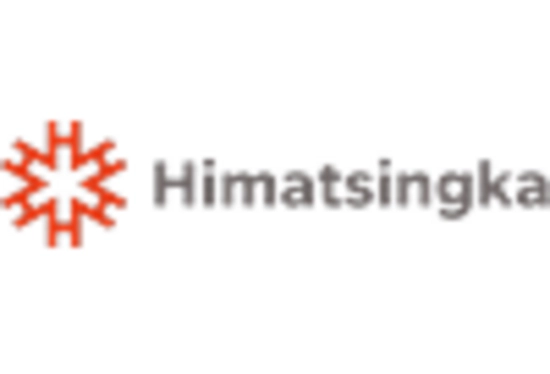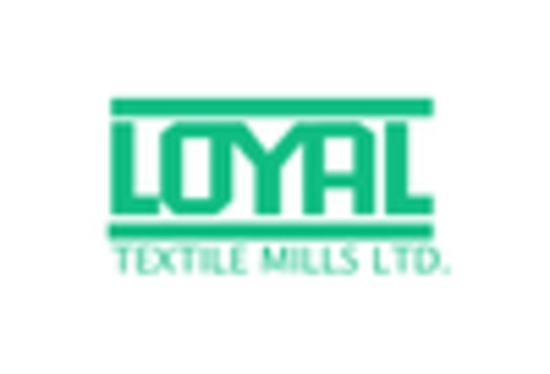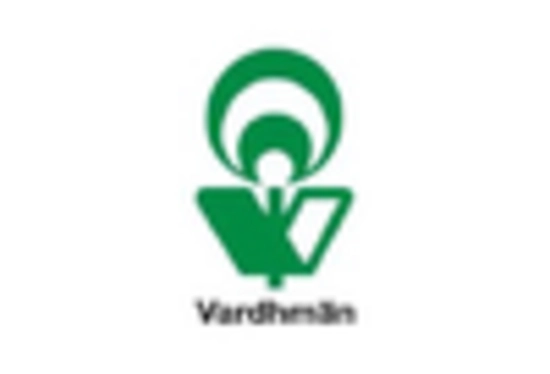-
EXECUTIVE SUMMARY
-
MARKET INTRODUCTION
-
Definition
-
Scope of the Study
- Research Objective
- Assumptions
- Limitations
-
RESEARCH METHODOLOGY
-
Overview
-
Data Mining
-
Secondary Research
-
Primary Research
- Primary Interviews and Information Gathering Process
- Breakdown of Primary Respondents
-
Forecasting Modality
-
Market Size Estimation
- Bottom-Up Approach
- Top-Down Approach
-
Data Triangulation
-
Validation
-
MARKET DYNAMICS
-
Overview
-
Drivers
-
Restraints
-
Opportunities
-
MARKET FACTOR ANALYSIS
-
Value Chain Analysis
-
Porter’s Five Forces Analysis
- Bargaining Power of Suppliers
- Bargaining Power of Buyers
- Threat of New Entrants
- Threat of Substitutes
- Intensity of Rivalry
-
COVID-19 Impact Analysis
- Market Impact Analysis
- Regional Impact
- Opportunity and Threat Analysis
-
GLOBAL COTTON YARN MARKET, BY TYPE
-
Overview
-
Carded Yarn
-
Combed Yarn
-
Others
-
GLOBAL COTTON YARN MARKET, BY APPLICATION
-
Overview
-
Apparel
-
Home Textiles
-
Industrial Textiles
-
Other
-
GLOBAL COTTON YARN MARKET, BY REGION
-
Overview
-
North America
- US
- Canada
-
Europe
- Germany
- France
- UK
- Italy
- Spain
- Rest of Europe
-
Asia-Pacific
- China
- India
- Japan
- South Korea
- Australia
- Rest of Asia-Pacific
-
Rest of the World
- Middle East
- Africa
- Latin America
-
COMPETITIVE LANDSCAPE
-
Overview
-
Competitive Analysis
-
Market Share Analysis
-
Major Growth Strategy in the Global Cotton Yarn Market,
-
Competitive Benchmarking
-
Leading Players in Terms of Number of Developments in the Global Cotton Yarn Market,
-
Key developments and Growth Strategies
- New Product Launch/Service Deployment
- Merger & Acquisitions
- Joint Ventures
-
Major Players Financial Matrix
- Sales & Operating Income, 2022
- Major Players R&D Expenditure. 2022
-
COMPANY PROFILES
-
Texhong
- Company Overview
- Financial Overview
- Products Offered
- Key Developments
- SWOT Analysis
- Key Strategies
-
Weiqiao Textile
- Company Overview
- Financial Overview
- Products Offered
- Key Developments
- SWOT Analysis
- Key Strategies
-
Huafu
- Company Overview
- Financial Overview
- Products Offered
- Key Developments
- SWOT Analysis
- Key Strategies
-
Henan Xinye Textile
- Company Overview
- Financial Overview
- Products Offered
- Key Developments
- SWOT Analysis
- Key Strategies
-
BROS
- Company Overview
- Financial Overview
- Products Offered
- Key Developments
- SWOT Analysis
- Key Strategies
-
China Resources
- Company Overview
- Financial Overview
- Products Offered
- Key Developments
- SWOT Analysis
- Key Strategies
-
Huamao
- Company Overview
- Financial Overview
- Products Offered
- Key Developments
- SWOT Analysis
- Key Strategies
-
LUTAI TEXTILE
- Company Overview
- Financial Overview
- Products Offered
- Key Developments
- SWOT Analysis
- Key Strategies
-
Guanxing
- Company Overview
- Financial Overview
- Products Offered
- Key Developments
- SWOT Analysis
- Key Strategies
-
Hengfeng
- Company Overview
- Financial Overview
- Products Offered
- Key Developments
- SWOT Analysis
- Key Strategies
-
APPENDIX
-
References
-
Related Reports
-
-
LIST OF TABLES
-
GLOBAL COTTON YARN MARKET, SYNOPSIS, 2025-2034
-
GLOBAL COTTON YARN MARKET, ESTIMATES & FORECAST, 2025-2034 (USD BILLION)
-
GLOBAL COTTON YARN MARKET, BY TYPE, 2025-2034 (USD BILLION)
-
GLOBAL COTTON YARN MARKET, BY APPLICATION, 2025-2034 (USD BILLION)
-
NORTH AMERICA: COTTON YARN MARKET, BY TYPE, 2025-2034 (USD BILLION)
-
NORTH AMERICA: COTTON YARN MARKET, BY APPLICATION, 2025-2034 (USD BILLION)
-
US: COTTON YARN MARKET, BY TYPE, 2025-2034 (USD BILLION)
-
US: COTTON YARN MARKET, BY APPLICATION, 2025-2034 (USD BILLION)
-
CANADA: COTTON YARN MARKET, BY TYPE, 2025-2034 (USD BILLION)
-
CANADA: COTTON YARN MARKET, BY APPLICATION, 2025-2034 (USD BILLION)
-
EUROPE: COTTON YARN MARKET, BY TYPE, 2025-2034 (USD BILLION)
-
EUROPE: COTTON YARN MARKET, BY APPLICATION, 2025-2034 (USD BILLION)
-
GERMANY: COTTON YARN MARKET, BY TYPE, 2025-2034 (USD BILLION)
-
GERMANY: COTTON YARN MARKET, BY APPLICATION, 2025-2034 (USD BILLION)
-
FRANCE: COTTON YARN MARKET, BY TYPE, 2025-2034 (USD BILLION)
-
FRANCE: COTTON YARN MARKET, BY APPLICATION, 2025-2034 (USD BILLION)
-
ITALY: COTTON YARN MARKET, BY TYPE, 2025-2034 (USD BILLION)
-
ITALY: COTTON YARN MARKET, BY APPLICATION, 2025-2034 (USD BILLION)
-
SPAIN: COTTON YARN MARKET, BY TYPE, 2025-2034 (USD BILLION)
-
SPAIN: COTTON YARN MARKET, BY APPLICATION, 2025-2034 (USD BILLION)
-
UK: COTTON YARN MARKET, BY TYPE, 2025-2034 (USD BILLION)
-
UK: COTTON YARN MARKET, BY APPLICATION, 2025-2034 (USD BILLION)
-
REST OF EUROPE: COTTON YARN MARKET, BY TYPE, 2025-2034 (USD BILLION)
-
REST OF EUROPE: COTTON YARN MARKET, BY APPLICATION, 2025-2034 (USD BILLION)
-
ASIA-PACIFIC: COTTON YARN MARKET, BY TYPE, 2025-2034 (USD BILLION)
-
ASIA-PACIFIC: COTTON YARN MARKET, BY APPLICATION, 2025-2034 (USD BILLION)
-
JAPAN: COTTON YARN MARKET, BY TYPE, 2025-2034 (USD BILLION)
-
JAPAN: COTTON YARN MARKET, BY APPLICATION, 2025-2034 (USD BILLION)
-
CHINA: COTTON YARN MARKET, BY TYPE, 2025-2034 (USD BILLION)
-
CHINA: COTTON YARN MARKET, BY APPLICATION, 2025-2034 (USD BILLION)
-
INDIA: COTTON YARN MARKET, BY TYPE, 2025-2034 (USD BILLION)
-
INDIA: COTTON YARN MARKET, BY APPLICATION, 2025-2034 (USD BILLION)
-
AUSTRALIA: COTTON YARN MARKET, BY TYPE, 2025-2034 (USD BILLION)
-
AUSTRALIA: COTTON YARN MARKET, BY APPLICATION, 2025-2034 (USD BILLION)
-
SOUTH KOREA: COTTON YARN MARKET, BY TYPE, 2025-2034 (USD BILLION)
-
SOUTH KOREA: COTTON YARN MARKET, BY APPLICATION, 2025-2034 (USD BILLION)
-
REST OF ASIA-PACIFIC: COTTON YARN MARKET, BY TYPE, 2025-2034 (USD BILLION)
-
REST OF ASIA-PACIFIC: COTTON YARN MARKET, BY APPLICATION, 2025-2034 (USD BILLION)
-
REST OF THE WORLD: COTTON YARN MARKET, BY TYPE, 2025-2034 (USD BILLION)
-
REST OF THE WORLD: COTTON YARN MARKET, BY APPLICATION, 2025-2034 (USD BILLION)
-
MIDDLE EAST: COTTON YARN MARKET, BY TYPE, 2025-2034 (USD BILLION)
-
MIDDLE EAST: COTTON YARN MARKET, BY APPLICATION, 2025-2034 (USD BILLION)
-
AFRICA: COTTON YARN MARKET, BY TYPE, 2025-2034 (USD BILLION)
-
AFRICA: COTTON YARN MARKET, BY APPLICATION, 2025-2034 (USD BILLION)
-
LATIN AMERICA: COTTON YARN MARKET, BY TYPE, 2025-2034 (USD BILLION)
-
LATIN AMERICA: COTTON YARN MARKET, BY APPLICATION, 2025-2034 (USD BILLION)
-
LIST OF FIGURES
-
RESEARCH PROCESS
-
MARKET STRUCTURE FOR THE GLOBAL COTTON YARN MARKET
-
MARKET DYNAMICS FOR THE GLOBAL COTTON YARN MARKET
-
GLOBAL COTTON YARN MARKET, SHARE (%), BY TYPE, 2022
-
GLOBAL COTTON YARN MARKET, SHARE (%), BY APPLICATION, 2022
-
GLOBAL COTTON YARN MARKET, SHARE (%), BY REGION, 2022
-
NORTH AMERICA: COTTON YARN MARKET, SHARE (%), BY REGION, 2022
-
EUROPE: COTTON YARN MARKET, SHARE (%), BY REGION, 2022
-
ASIA-PACIFIC: COTTON YARN MARKET, SHARE (%), BY REGION, 2022
-
REST OF THE WORLD: COTTON YARN MARKET, SHARE (%), BY REGION, 2022
-
GLOBAL COTTON YARN MARKET: COMPANY SHARE ANALYSIS, 2022 (%)
-
TEXHONG: FINANCIAL OVERVIEW SNAPSHOT
-
TEXHONG: SWOT ANALYSIS
-
WEIQIAO TEXTILE: FINANCIAL OVERVIEW SNAPSHOT
-
WEIQIAO TEXTILE: SWOT ANALYSIS
-
HUAFU: FINANCIAL OVERVIEW SNAPSHOT
-
HUAFU: SWOT ANALYSIS
-
HENAN XINYE TEXTILE: FINANCIAL OVERVIEW SNAPSHOT
-
HENAN XINYE TEXTILE: SWOT ANALYSIS
-
BROS.: FINANCIAL OVERVIEW SNAPSHOT
-
BROS.: SWOT ANALYSIS
-
CHINA RESOURCES: FINANCIAL OVERVIEW SNAPSHOT
-
CHINA RESOURCES: SWOT ANALYSIS
-
HUAMAO: FINANCIAL OVERVIEW SNAPSHOT
-
HUAMAO: SWOT ANALYSIS
-
LUTAI TEXTILE: FINANCIAL OVERVIEW SNAPSHOT
-
LUTAI TEXTILE: SWOT ANALYSIS
-
GUANXING: FINANCIAL OVERVIEW SNAPSHOT
-
GUANXING: SWOT ANALYSIS
-
HENGFENG: FINANCIAL OVERVIEW SNAPSHOT
-
HENGFENG: SWOT ANALYSIS









Leave a Comment